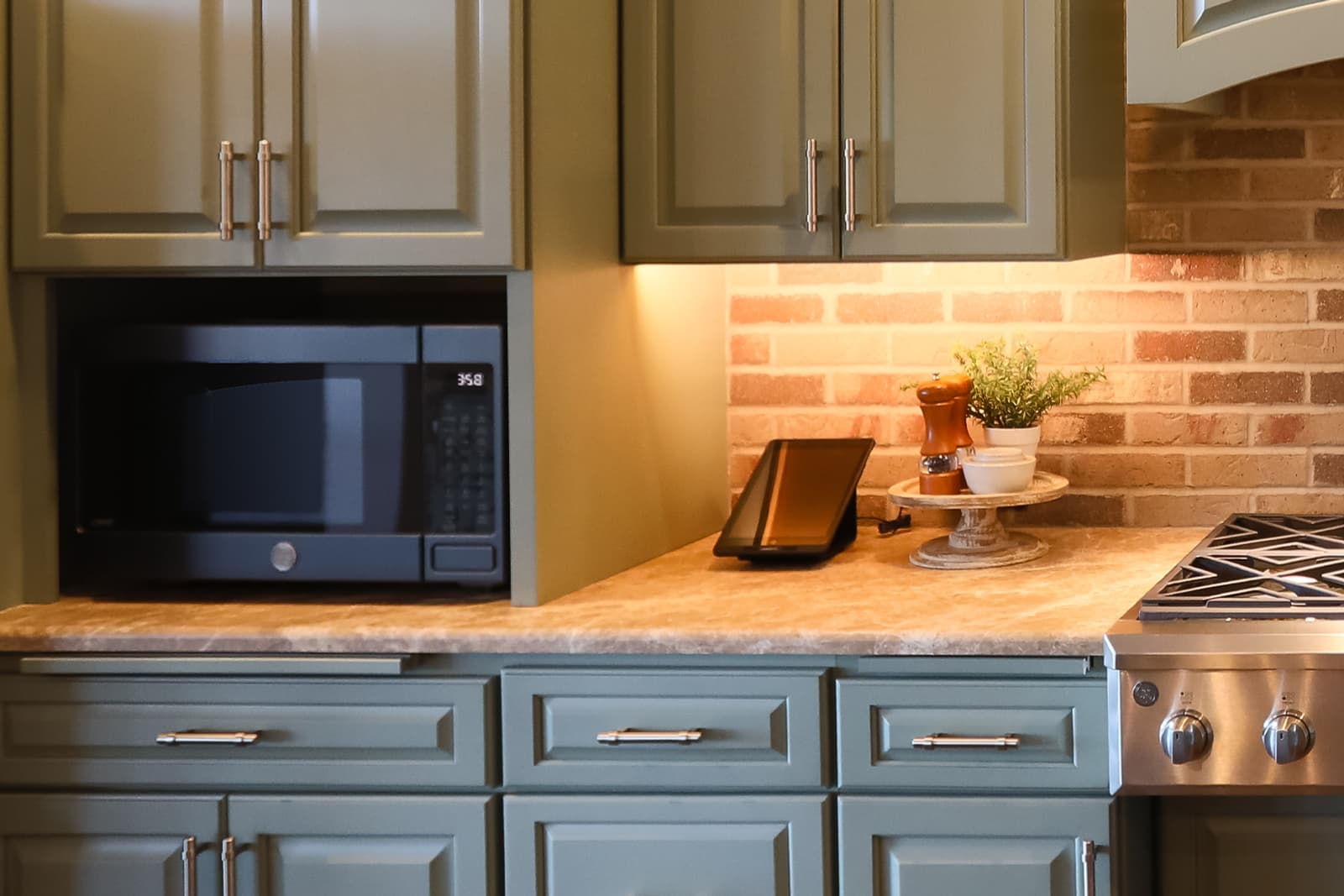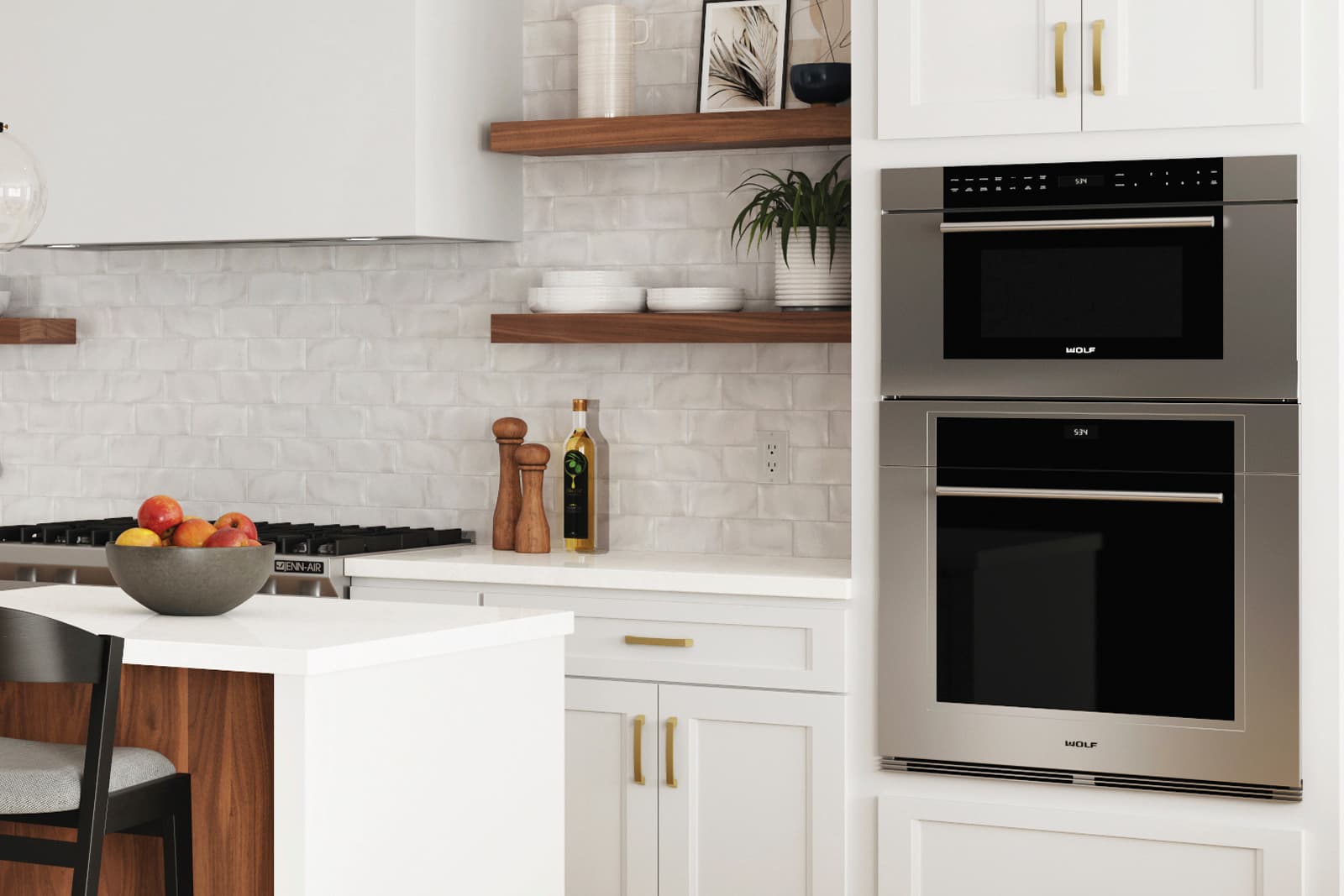Microwave Cabinet Integration Styles: Kitchen Microwave Cabinets Design

Integrating a microwave into your kitchen cabinetry offers a seamless and stylish solution, enhancing both functionality and aesthetics. Careful consideration of design style, material choices, and placement significantly impacts the overall kitchen design. This exploration delves into various integration styles and their unique attributes.
Microwave Cabinet Integration Styles: Design Examples
The integration of a microwave into custom cabinetry allows for a personalized touch, adapting to diverse kitchen aesthetics. Below, we showcase three distinct kitchen layouts featuring integrated microwave cabinets.
| Style | Material | Finish | Hardware |
|---|---|---|---|
| Modern Minimalist | High-gloss lacquered MDF, sleek stainless steel accents | High-gloss white or light grey; brushed stainless steel | Minimalist bar pulls in brushed nickel or matte black |
| Rustic Farmhouse | Reclaimed wood, possibly with a distressed finish; solid wood doors | Natural wood stain or painted white with a slightly distressed finish | Antique brass or brushed nickel cup pulls; possibly wrought iron accents |
| Sleek Contemporary | High-pressure laminate (HPL) or thermofoil; glass panels | Deep charcoal grey or matte black; clear or frosted glass | Sleek, integrated handleless system or minimalist recessed pulls in brushed steel |
Built-in Microwave Cabinet with Pull-out Shelf
Imagine a built-in microwave cabinet, approximately 36 inches wide, 24 inches high, and 18 inches deep. The cabinet itself is constructed from high-quality maple wood, finished in a warm honey tone. The microwave sits flush within the cabinetry, seamlessly integrated. The key feature is a smoothly operating, full-extension pull-out shelf situated beneath the microwave. This shelf, made of sturdy, stainless steel, provides easy access to frequently used items, such as plates, bowls, and utensils, eliminating the need to reach awkwardly behind the microwave. The entire unit is meticulously crafted, ensuring durability and a polished look.
Over-the-Range Microwaves vs. Built-in Microwave Cabinets, Kitchen microwave cabinets design
Over-the-range microwaves, such as the LG LMVM1735F, offer a space-saving solution by combining the microwave with a range hood. However, they often have limited cooking capacity and may lack the sleek integration of built-in models. Built-in microwave cabinets, like those offered by Bosch, provide a more customizable and aesthetically pleasing option, but require dedicated cabinet space and professional installation. They typically offer greater cooking capacity and more advanced features. The choice depends on individual kitchen design, budget, and functional needs. For example, a smaller kitchen might benefit from the space-saving nature of an over-the-range model, while a larger kitchen with ample counter space might better suit a built-in microwave cabinet for a more integrated and sophisticated look.
Optimizing Microwave Cabinet Placement and Functionality
Strategic placement of microwave cabinets significantly impacts kitchen efficiency and aesthetic appeal. Careful consideration of workflow, accessibility, and overall kitchen design is crucial for optimal functionality and user experience. Ignoring these factors can lead to an inconvenient and inefficient kitchen layout.
Optimal placement ensures easy access to the microwave without disrupting the overall kitchen flow, enhancing both convenience and the overall aesthetic of the space. A poorly placed microwave can become a significant obstacle, hindering movement and efficiency.
Microwave Cabinet Placement in Different Kitchen Layouts
The ideal location for a microwave cabinet varies depending on the kitchen’s layout and the user’s habits. Considering factors such as proximity to other appliances and workspaces is key to maximizing efficiency.
- L-shaped kitchens: Ideally positioned within the L-shaped configuration, close to the cooking area and prep zone for seamless workflow. A corner cabinet could also be a space-saving solution.
- U-shaped kitchens: One leg of the U is often designated as the main work area; placing the microwave within easy reach of this area maintains a smooth cooking workflow. Avoid placing it in a dead corner.
- Galley kitchens: Due to limited space, the microwave might be incorporated above the countertop or in a wall-mounted cabinet, ensuring it’s easily accessible without obstructing the narrow walkway.
- Island kitchens: The microwave can be integrated into the island itself, providing convenient access from multiple areas of the kitchen. However, ensure it does not obstruct the island’s primary function.
Space-Saving Microwave Cabinet Solutions for Small Kitchens
Small kitchens often present challenges in integrating appliances without compromising valuable space. Creative design solutions are necessary to maximize functionality while minimizing footprint.
- Over-the-range microwaves: These models are mounted above the stove, freeing up valuable counter space. However, careful consideration of ventilation is necessary to prevent grease buildup.
- Under-counter microwaves: These compact models are installed beneath the countertop, saving valuable counter space. They are less visually prominent but might require bending down to access.
- Slim-depth microwaves: Designed for shallow cabinets, these microwaves offer the same functionality in a reduced depth, making them perfect for smaller spaces. This requires careful cabinet design to accommodate the specific depth.
- Built-in microwave drawers: These appliances slide out from a cabinet, offering a space-saving and sleek design. They can be more expensive but offer a stylish and functional solution.
Microwave Cabinet with Integrated Ventilation and Lighting
Integrating ventilation and lighting directly into the microwave cabinet enhances both functionality and aesthetics. This approach creates a more efficient and user-friendly workspace.
The cabinet could be constructed from high-quality materials such as solid wood or high-gloss laminate, chosen for durability and easy cleaning. The ventilation system might consist of a small, quiet exhaust fan discreetly placed within the cabinet, connected to an external duct or a recirculating filter system. This system effectively removes steam and cooking odors. Integrated LED lighting can be installed beneath the microwave shelf, providing illumination within the cabinet and enhancing visibility. A motion sensor could automate the lighting, enhancing convenience.
Aesthetic Considerations and Design Trends

Integrating a microwave into your kitchen cabinetry requires careful consideration of aesthetics, ensuring it complements your overall kitchen design rather than clashing with it. The right choices in materials, colors, and cabinet styles can elevate your kitchen’s visual appeal significantly. This section explores current trends and practical style choices for microwave cabinet integration.
Current Microwave Cabinet Design Trends
The current trends in microwave cabinet aesthetics focus on seamless integration, high-quality materials, and a sophisticated overall look. The following table highlights three prominent trends:
| Trend | Material Examples | Color Palette | Style Description |
|---|---|---|---|
| Minimalist Integration | High-gloss lacquered wood, stainless steel, matte-finish thermofoil | Neutral tones (white, gray, beige), black, muted greens | Clean lines, handleless cabinets, flush-mounted microwave, emphasis on simplicity and functionality. Often features a cohesive color scheme throughout the kitchen. |
| Rustic Farmhouse Charm | Reclaimed wood, distressed painted wood, natural stone accents | Warm neutrals (cream, ivory, taupe), muted blues and greens, natural wood tones | Textured surfaces, visible wood grain, antique-style hardware, and a sense of warmth and coziness. The microwave is integrated to maintain the rustic aesthetic. |
| Modern Contemporary Elegance | High-gloss acrylic, glass, sleek metallic finishes | Bold colors (navy, emerald green, deep red), metallic accents (gold, copper, brushed nickel), black and white | Sharp lines, geometric patterns, integrated lighting, and a focus on luxury materials. The microwave is often hidden behind a sleek panel matching the surrounding cabinetry. |
Microwave Cabinet Door Styles
The choice of cabinet door style significantly impacts the overall aesthetic of your microwave cabinet. Three popular styles offer distinct visual and practical benefits.
Kitchen microwave cabinets design – Shaker style doors, characterized by a simple recessed center panel framed by a raised edge, provide a timeless and versatile look. Their understated elegance suits various kitchen styles, from traditional to contemporary. Practical considerations include their relatively easy cleaning and moderate cost. The slightly raised frame adds visual interest without being overly ornate.
Slab doors, with their completely flat surface, offer a sleek, modern look. They are ideal for minimalist kitchens and create a clean, uncluttered appearance. Practical considerations include their susceptibility to showing fingerprints and the need for careful cleaning to maintain their pristine appearance. The absence of any raised elements emphasizes simplicity and sophistication.
Raised panel doors feature a raised central panel, creating a more traditional and formal look. The raised panel adds depth and texture to the cabinet face, providing a classic and elegant feel. Practical considerations include their ability to hide minor imperfections and their relative durability. However, the recessed areas can be more challenging to clean thoroughly.
Rewritten Article on Microwave Cabinet Design
[Insert rewritten article text here. This section would contain a rewritten version of the placeholder article, focusing on a more conversational and engaging tone, avoiding overly technical jargon, and presenting information in a more human-centric way. The rewritten article would maintain all factual information from the original but would be more accessible and relatable to the average reader.]
